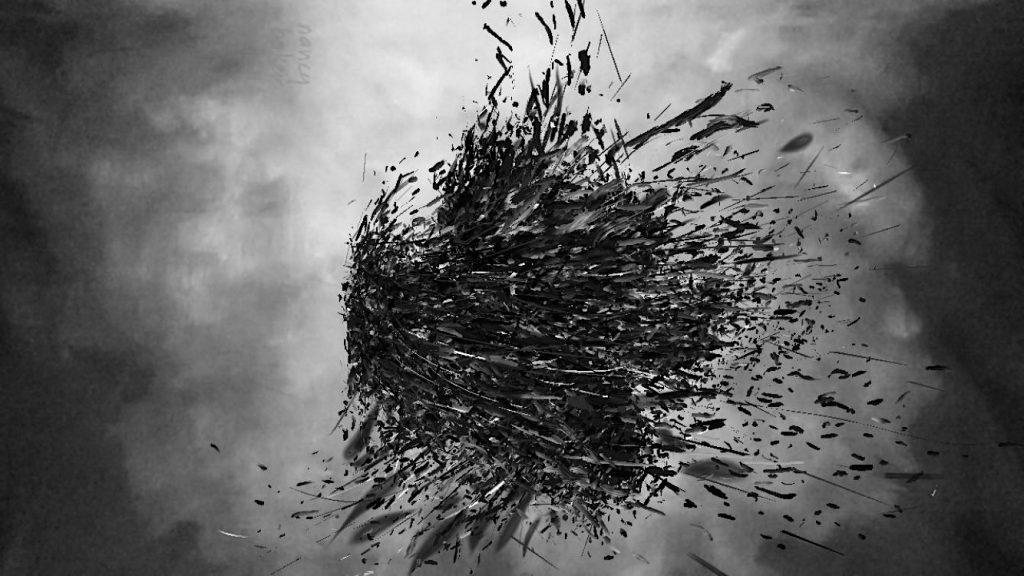
Artist Self-Releases Interactive Art Gallery 4thWall for iOS
Los Angeles-based fine artist Nancy Baker Cahill brought her creative visions into the forefront of the technological and artistic worlds this month by releasing 4thWall, an iOS app that allows users to explore virtual renderings of Cahill’s art anywhere on the planet.
Before delving into AR, Cahill has established herself primarily in more traditional media, creating dynamic works done mostly in charcoal portraying abstract forms, both fluid and fragmented. Her oeuvre, inspired in part by bullet strikes and reminiscent of starbursts, shrapnel, or studies of flowing water or muscle, are rendered in deep blacks and quicksilver grays. With the advent of 4thWall, Cahill has reinterpreted some of her past paper-based works’ themes into new virtual offerings for AR use.
Developed in partnership with the artist by Drive Studios, 4thWall features interactive, full-scale AR representations of four pieces from Cahill’s Hollow Point series that users can place and interact with in the real world courtesy of the magic of augmented reality and the latest generation of devices and software which have finally made functional AR apps viable.
The four works featured in the app are chaotic and intriguing, reflecting the artist’s intent of capturing “moments of cataclysmic rupture and beauty” and “biomorphic, chaotic body forms.” They appear well-rendered and faithfully displayed (at least on this reviewer’s iPhone 7), though the app’s AR renderings do suffer from occasional jitteriness or shifts in scale that seem to plague this initial generation of AR apps.
4thWall’s interface is clean and intuitive, and navigation is an ease thanks to an invitingly simple design featuring text and icons in personable, hand-written scrawl. Overall, 4thWall feels like an intimate conveyance of one artist’s creative mind rather than just another mass-produced, cookie-cutter AR gimmick.
In addition to exploring Cahill’s AR art, the app’s two other modes add to impression of intimacy. Along with being able to tour a virtual gallery of Cahill’s art, 4thWall also includes other AR features, such as a holographic rendering of Cahill describing her works. In another immersive mode, a user “walks” into a floating door to find themselves “inside” a photorealistic recreation of Cahill’s private studio, replete with hanging works of art and a cluttered work-desk.
Above: 4thWall’s three modes —including the piece Hollow Point 101— reviewed near Seeflection HQ.
In an illuminating interview with self-described “playwright and technologist” Kat Mustatea of Women@Forbes, Chill described her inspiration for 4thWall as well as her creative process in AR/VR. According to Cahill, she first forayed into the virtual art realm while experimenting with VR games, eventually stumbling into art programs such as Tilt Brush after realizing that art in VR was a “perfect next step.” She describes the experience of painting in VR as entirely different from her familiar territory of paper and graphite, expressing the feeling that “being able to draw in 360 degrees around my body and in space […] serves as an amplification and expansion. I feel like working in VR has altered my own anatomy.”
However engrossing and complete the experience of playing and creating in true virtual reality feels, the technology currently requires costly, obtrusive, and otherwise inconvenient purpose-build headsets⎯or at the very least imperfect solutions such as Google Cardboard. Recognizing this obstacle, Cahill sought to share her work not in pure VR, but rather in a more easily-accessible AR medium requiring only a compatible smartphone rather than an expensive VR rig. Despite the unparalleled immersion and totality of art in a VR experience, Cahill says, “you need to have hardware to experience it. So then translating it into AR means being able to share it and democratize the experience of it.”
Additionally, Cahill states on her app’s website that 4thWall, “is also a means of collectively sharing in an experience that might otherwise be unavailable to people either living far from LA, or without the hardware necessary for a singular, VR experience.” In addition to freely making her art available to a wider audience via AR, Cahill’s decision to show her works in AR rather than VR also enhances the experience and allows for users to interact with Cahill’s work and co-create new contexts for the work:
“As an artist, I am always looking to expand and engage a larger and more diverse audience. Our hope is that viewers all over the world respond to the drawings and harness their own creativity to place them in all kinds of contexts–art truly can be anywhere. We encourage viewers to tag their experiences, either as videos or stills, across social media platforms using the hashtags: #4thwallapp, #nancybakercahill and any #AR iterations they choose!”
The social aspect of the app and ease of recording still-frames and video lend to some interesting user experiments with interacting with the art, and a perusal of the artist’s #4thwallapp hashtag on Instagram shows her wondrous, chaotic pieces appearing in a variety of interesting contexts, from messy bedrooms to the sky above airplane wings to scenic park-side paths.
Cahill’s work places her at the cutting edge of an almost entirely virgin realm of artistic expression⎯a moment perhaps as pivotal and unprecedented as the invention of photography or video⎯helping to shape not only the new ways in which art can be created and displayed in VR & AR, but also how these works can be shared, experienced and remade.







Leave A Comment